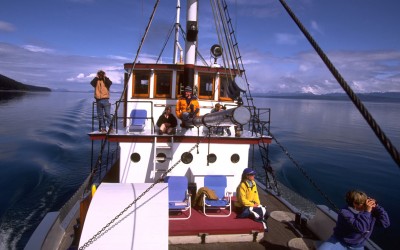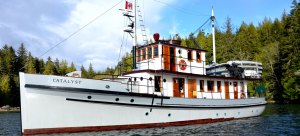Alaska at Eye Level

by Christine Hemp, Boston Globe
 Vintage 1932 motor vessel offers comfort, companionability, exploring in hard-to-reach spots, and even solitude.
Vintage 1932 motor vessel offers comfort, companionability, exploring in hard-to-reach spots, and even solitude.
FREDERICK SOUND, Alaska – A miniature iceberg glistens and slowly melts on a chafing dish. The dining room table, steaming with plates of fresh salmon, is set for 13. The salon glows – not only from the candles flickering under the glacial centerpiece or the fire in the antique paneled fireplace – but from the faces of nine passengers who just that afternoon witnessed the boom and spray of calving glaciers from as close as anyone can get.
This is no ordinary week-long boat trip to southeast Alaska. Forget cruise ships the size of Anchorage. Forget your cellphone (it won’t work up there). Forget even that you live in the 21st century. When you travel the Inside Passage from Petersburg to Juneau on the MV Westword or the MV Catalyst, two classic wooden motor yachts circa 1928, (MV Catalyst and business recently purchased and owned by Bill and Shannon Bailey and Pacific Catalyst II, Inc. of Friday Harbor, WA) you’re not only traveling through Alaskan wilderness, you’re traveling back in time – into an aesthetic most people don’t get to experience anymore. On what another journey can you sit down to dinner after a day of hiking and sea-kayaking, have the captain uncork a bottle of Ravenswood merlot, and regale you with the rich history of your vessel as well as techniques for warding off brown bears?
If you like predictable guided tours, this is not for you. A trip with the Pacific Catalyst is for those who love nature, yes, but who wish to see it eye-to-eye, not from above. To paddle into a cove where 500 sea lions roar and swim beside you, to hear humpback whales breathing on the next wave, to pick wild blueberries and have them appear in the muffins for breakfast – these are the treats of traveling on this broad-beamed, vintage, fantail boat sturdy as a riveter, graceful as a countess.
Both boats carry a maximum of 11 passengers, plus crew. Constructed originally as marine research boats and used also for whaling vessel, these 74- and 86-foot boats can maneuver through icebergs, around islands, and into tiny coves, most passenger vessels in Alaska wouldn’t dream of approaching. One night we anchored, alone as usual, in a magnificent fiord called “Ford’s Terror” where the sound of waterfalls sang us to sleep and the 25-foot tide gushed through the passage. Another day we negotiated our way through a plethora of icebergs and snuggled up as close to Dawes Glacier as we could, watching chunks of ice the size of the Empire State Building thunder into the water below. Pressing from above us was a rank of snow-peaked mountains.
One of the most remarkable features of eight days aboard the was the enthusiasm of the crew. When a pod of humpback whales appeared in Frederick Sound, for example, Captain Pat Sharpe cut the engines and relayed sightings as if the mammoth force of a leviathan blowing and breaching was as fresh as the first day he had ever seen one. Naturalist Hans Bruning waxed poetic about the love life of kelp spores and the medicinal qualities of willow; engineer John Williams happily kept his ear tipped to the comforting “sweet-potato sweet-potato sweet-potato” thrum of the 1924 Atlas Imperial 4-cylinder engine. He invited everyone to climb down to the engine room to admire the pistons, gauges, and crankshafts – thick with shiny coats of green paint.
The kind of people who work for the Pacific Catalyst are adventurers themselves. Sharpe is a competitive skier and whitewater kayaker, and his experience on boats includes working on yachts owned by the likes of the late Malcolm Forbes. Bruning specializes in whales, and his knowledge of flora and fauna is staggering. Besides baking the best chocolate mint cookies, chef Echo Harbison during winter months is earning a graduate degree in comparative music. Williams is a Tom Robbins junkie and was unmatched as a raconteur.
Rather than making the trip all about them, though, the crew was mostly interested in finding a new inlet to share or experiencing with us the bigness, rawness, and surprise of Alaska. One night we floated in the skiff and watched the sea phosphoresce, transforming spawning salmon into ghostfish underwater, while in the sky the Leonid meteor showers echoed the fishes’ movements. Another day we hiked up to a high mountain lake above Baranof, stopping at a natural hot spring on the way back. People were free to do as they wished, not forced to participate in every activity, and some stayed behind for solitude.
The cabins, like the other areas on the boat, are comfortable as well as aesthetically pleasing. Each one can accommodate two to five people easily. Fine oak woodwork, ample comforters, and old-fashioned lamps hark back to a time when expert craftsmanship was part and parcel of practicality. Westword’s design also allows for privacy, even with 13 aboard. There are always places besides one’s cabin to find a quiet spot: the foredeck or aft (which is covered) or even the quiet of the salon, where people often read or wait for the next pod of Dall’s dolphins to appear at the bow of the boat.
The most memorable shore adventure, however, was our day at Admiralty Island. Armed with a rifle, Sharpe led the way through woods along a well-traveled bear trail. As we approached the open meadow, eagles dove for the masses of spawning salmon, the evening light shone clear, and a heron’s moan echoed against the huge mountains. When we arrived at the creek, which was frothy and humped with salmon battling upstream, bear tracks were everywhere. The entire field lay flattened and strewn with fish heads and scales. Fresh scat and leaves overturned within the last hour – these signs were almost more thrilling than encountering a bear itself. We did see a cub in the trees across the stream, but we returned to the boat that night filled with animal awareness, our primal selves alert.
The passengers were always game for adventure and were encouraged to participate in crew activities like cooking, loading, and even the occasional moment at the helm under Sharpe’s supervision. Most had a broad range of travel experience (not necessarily wilderness travel) and diverse knowledge. This particular journey included an art museum director, a former city planner, a horse trainer, a lawyer, a corporate entrepreneur, a nurse, a hospital administrator, and a medical training specialist.
Those who choose Pacific Catalyst seem to be interested in being part of the environment rather than wanting to merely look at it. Video cameras were scarce, and by the second day, even snapshot cameras felt extraneous. The group was more interested in recounting the day’s adventures together over wine, fresh crab, and halibut. Some evenings were filled with singing and playing musical instruments.
One night, a few of us stayed up on deck to watch the Northern Lights. Under the shimmering sky with only the slap of the water against the hull, Sharpe said, “Even when there’s silence in Alaska, it’s big silence.” To travel into the wilderness on this seasoned boat you not only see Alaska, but you also experience it with each of your senses, in all its roar and silence.
——————————————————————————–
Christine Hemp is a poet and writer whose work has been heard recently on National Public Radio’s “Morning Edition.” She lives in Port Townsend, Wash.
